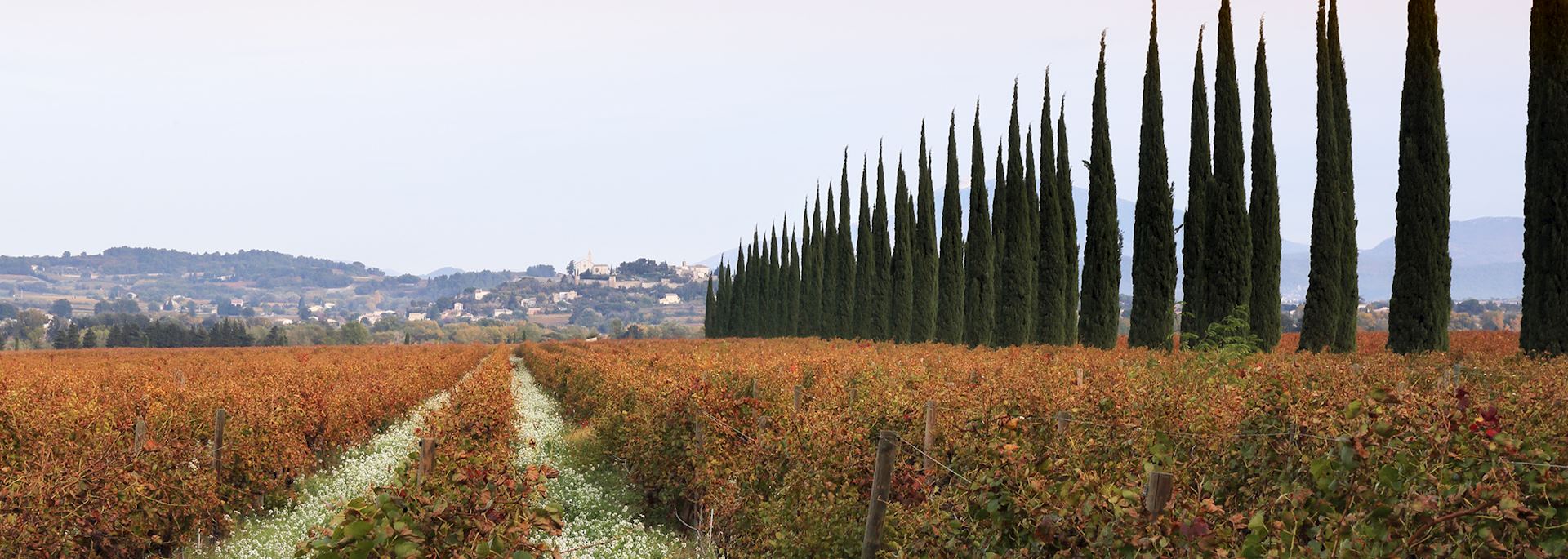Rows and rows of vines blanket the hills around the tiny medieval village of Châteauneuf-du-Pape, just north of Avignon. It lies at the heart of one of the world's most prestigious wine-growing regions, where strict rules control the cultivation of grapes as well as wine production.
Viticulture is an ancient art here, and the owners of the historic wine estates that shape the region are fiercely proud and protective of their precious wines.
 The Romans were the first to plant grapes in the region, but wine growing took a leap forward with the help of the medieval popes based in nearby Avignon. Their avid interest in wine production — and consumption — helped to improve the quality of the local product. At the time it was difficult to transport and conserve wine and so it was only ever consumed locally. If the popes were to have access to good wines, they needed them to be produced close to home.
The Romans were the first to plant grapes in the region, but wine growing took a leap forward with the help of the medieval popes based in nearby Avignon. Their avid interest in wine production — and consumption — helped to improve the quality of the local product. At the time it was difficult to transport and conserve wine and so it was only ever consumed locally. If the popes were to have access to good wines, they needed them to be produced close to home.
In 1317, Pope John XXII built a castle on a hill as a summer retreat in an area that was to become known as Châteauneuf-du-Pape, or New Castle-of-the-Pope. He ordered that the surrounding fields should be planted with vines to ensure his court had its own steady supply of wine, and he oversaw production personally.
The ruins of the medieval castle still stand in the village of the same name, although much of the stone was removed for other building work after the Revolution and the remaining donjon (keep) was nearly destroyed in World War II.
What makes much of the region's terrain particularly good for grape growing is a thick layer of galets roulés (large round pebbles left behind by receding glaciers) that cover the soil. The stones absorb the heat of the sun during the day and release it at night, giving the grapes a steadier temperature range and allowing them to ripen more quickly.
The stones also help to retain moisture in the soil, protecting the grapes during hot, dry summers. Contrary to popular opinion, not all the vineyards here have galets and some remove them from the soil to prevent over ripening.
You can visit many of the historic wine estates of the region to tour the vineyards, learn about cultivation and have tutored tastings. About 95% of the wine produced in the region is red, and strict rules have governed production since the early 20th century, when wine fraud became an issue. The local rules led to the establishment of the Appellation d'Origine Protégée (AOP; controlled destination of origin) system now used across Europe for a variety of agricultural products.
Only 18 grape varieties are permitted in the Châteauneuf-du-Pape AOC, and all blends must be predominantly grenache. The red wines of the region have an earthy taste with warm, ripe tones and a high alcohol content, while the whites are typically drunk young. No rosé is permitted. Visiting one of the local estates is the opportunity to learn more or just to enjoy a tasting in the home of these fine wines.
who's been there
Start planning your tailor-made trip to Ch芒teauneuf-du-Pape wine region by contacting one of our France specialists
-
01993 838 92501993 838 925
- Make an enquiry
Places near Ch芒teauneuf-du-Pape wine region
- Orange 6 miles away
- Avignon 8 miles away
- L'Isle-sur-la-Sorgue 15 miles away
- Pont-du-Gard 17 miles away
- 厂补颈苍迟-搁茅尘测-诲别-笔谤辞惫别苍肠别 19 miles away
- 鲍锄猫蝉 21 miles away
- Gordes 21 miles away
- Les-Baux-de-Provence 22 miles away
- 惭茅苍别谤产别蝉 25 miles away
- Roussillon 26 miles away
- Arles 29 miles away
- Aix-en-Provence 48 miles away
- Provence 69 miles away
- 搁丑么苍别-础濒辫别蝉 83 miles away
- Saint-Tropez 106 miles away
- The French Riviera 107 miles away
- Grasse 108 miles away
- Saint-Paul-de-Vence 117 miles away
- Lyon 118 miles away
- Antibes 120 miles away
- Nice 123 miles away
- Saint-Jean-Cap-Ferrat 127 miles away
- 脠锄别 128 miles away
- Monaco and Monte Carlo 132 miles away
- Talloires 141 miles away
- Annecy 143 miles away
- Chamonix 159 miles away
- Dordogne 160 miles away
- 厂补谤濒补迟-濒补-颁补苍茅诲补 188 miles away
- La Roque-Gageac 188 miles away
- Castelnaud-la-Chapelle 190 miles away
- Beynac-et-Cazenac 191 miles away
- 厂补颈苍迟-脡尘颈濒颈辞苍 253 miles away
- Bordeaux 273 miles away
- Alsace 280 miles away
- Ch芒teau de Cheverny 289 miles away
- Ch芒teau de Chenonceau 290 miles away
- Ch芒teau de Chambord 294 miles away
- Ch芒teau de Chaumont-sur-Loire 295 miles away
- Amboise 298 miles away


